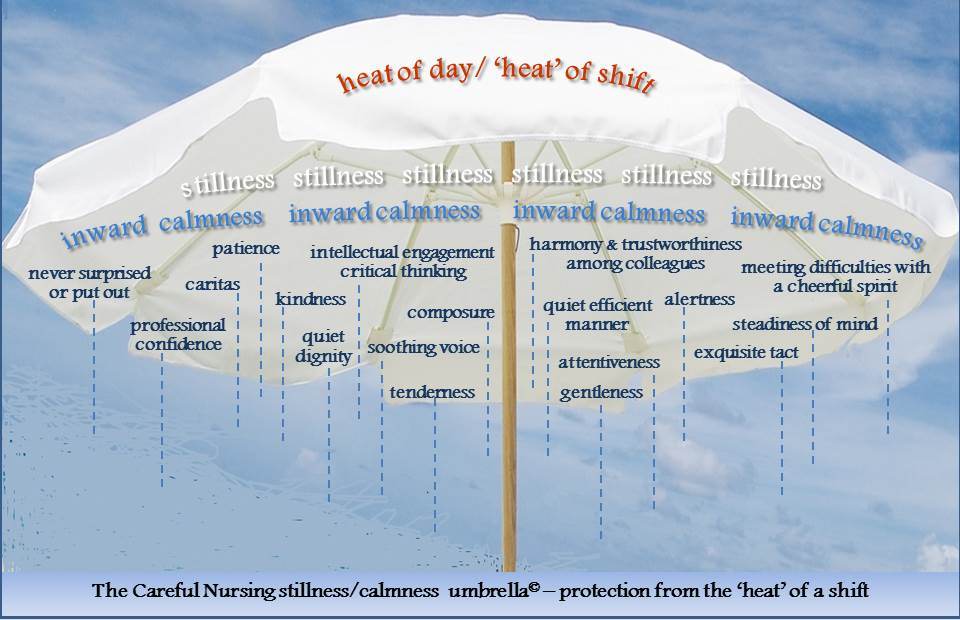Contagious Calmness
In a nutshell . . . .
Here you're introduced to contagious calmness, the first of six ideas that describe the activities and attitudes we implement in bringing the Therapeutic Milieu to life. This calmness is infectious. Like many nurses, you may find that contagious calmness becomes your favourite Careful Nursing idea.
You'll come to see why contagious calmness is the first idea of the Therapeutic Milieu – because it provides an important foundation for implementation of the other five Therapeutic Milieu ideas. In fact, implementation of all Careful Nursing ideas depend on our ability to be calm and communicate calmness to everyone around us.
You'll be able to read about and reflect on the calmness umbrella and how it can shade us from the "heat" of a hospital shift.
You have probably observed that some of us are naturally calmer than others. But we can all become naturally calm.
So, wherever we are on the calmness scale, contagious calmness comes with a precondition: the practice of "stillness" (any form of meditation) during our own personal time for at least five minutes every day.
The practice of "stillness" every day is a "must do" to truly practice Careful Nursing very well.
Introduction
Contagious calmness is the first concept of the Therapeutic Milieu because it is directly supported by nurses' practice of meditative "stillness" during personal time for at least five minutes every day. The quality of the Therapeutic Milieu as a whole is underpinned by nurses' contagious calmness. Contagious calmness is an enduring personal quality of alert peacefulness and composure even in circumstances which are very stressful, tense, threatening or hectic; it overcomes tendencies to be excessively anxious, distressed or agitated. Contagious calmness is reflected in nurses' attitudes and activities, for example, in a gentle manner, a clear and soothing voice, a demeanour of quiet dependability, and a composed alertness to the ever-changing needs of patients and practice situations. Contagious calmness communicates itself naturally to patients and others in their practice setting, helping them to overcome any excessive anxiety or stress and to feel calm. Contagious calmness establishes the emotional tone of the practice setting, helping patients to relax and fostering their comfort and healing.
Source of the term: contagious calmness
The term contagious calmness was coined by a Nurse Practitioner in the United States (Proudfoot 1983) when she wrote about 'Contagious calmness: a sense of calmness in acute care settings'. Knowledge of Proudfoot's work came repeatedly to mind during the content analysis of the 19th century documents which formed the basis for Careful Nursing. The term contagious calmness represents perfectly descriptions of the 19th century Irish nurses' seemingly effortless ability to create a sense of calm and order, even in the most distressing and chaotic practice situations, for example, during the Crimean war (Fitzgerald 1855, Taylor 1857, Terrot 1898).
The stillness/calmness umbrella: Shade from the 'heat' of a nursing practice shift
Developing the ability to be calm in all practice situations can seem a very challenging, sometimes an almost impossible idea to put into practice. Some of us are naturally calmer than others and we each begin further developing calmness only from where we are at the moment. The key to success in developing the enduring personal quality of contagious calmness lies in practicing stillness each day for at least five minutes (recall from the previous webpage on Infinite Transcendent Reality in life processes). In fact, exploration of the meaning of the word calm reveals that is closely associated with being still.
Our English word calm originates from the ancient Greek καῦμα and comes to us through the Latin cauma, words used to describe the stillness required to cope with the heat of the Mediterranean midday sun (Partridge 1958). Stillness and calmness are intimately associated and protect from the influence of heat; the heat of the sun or, by analogy, the heat of nurses' hospital shift.
In the world of chemistry an increase in temperature ('hotness' or heat) causes stress in a system and changes its equilibrium. By analogy, in the world of professional nursing practice the 'heat' of a shift can cause stress to our system and change its equilibrium, affecting the steadiness of our practice and our professional stability. When the heat of a shift is on us we need something to shade us from it; practicing at least five minutes of stillness each day creates for us a stillness/calmness umbrella:

Creating, preserving and keeping with us our very own stillness/calmness umbrella allows us, naturally over time, to develop a deep-down quality of calmness. Calmness becomes a way of life.
Practicing with contagious calmness
Contagious calmness enables us to develop all the qualities portrayed under the calmness/stillness umbrella. Calmness enables us to have a gentle manner, a soothing voice, and display quiet dependability in all that we do. It enables us to have an attitude of composed alertness to the ever-changing needs of patients and practice situations and to have confidence in our ability to meet these needs. When we are calm we are better able to assess patients' condition and to judge clearly what actions are necessary to protect and treat patients.
When we are calm the speed of time passing can seem to slow down so that we may feel as though we have more time; nurses who practice contagious calmness report that they do not feel so rushed. Check out this blog about time passing and feeling too busy http://www.carefulnursing.ie/go/blog/2014-10/no-time-too-busy-
Contagious calmness 'I will' statements
Take a few moments to sit quietly, close your eyes and assess how calm you feel in yourself. Bring to mind some recent practice experiences. On a scale of 1 to 10, how would you rate your level of calmness during your shift? To what extent were you aware of your own inward calmness during your shift? How well were you able to communicate a sense of calm to the people you cared for and to your colleagues and assistants?

Based on your assessment of your current level of contagious calmness, decide what you will do to further develop in yourself this enduring personal quality of contagious calmness. In what ways will you enact contagious calmness to contribute to creation of a therapeutic milieu in your practice setting?
Examples of contagious calmness 'I will' statements:
. . . take some deep breaths and remember calmness each time I cleanse my hands
. . . practice the stillness exercise every day
. . . . . . . . . . . . . . . . . . . . . . . . remember to take pauses for calmness during my shift
. . . . . . . . . . . . . . . . . . . . . . . . reconnect with stillness during my work
References
Fitzgerald D (1855) Confidential Report on the Nursing System Since Its Introduction to the Crimea on the 23rd January 1855. War Office 43/97/155656/439. Copy in Bridgeman, M.F. 1854-1856, An Account of the Mission of the Sisters of Mercy in the Military Hospitals of the East, Beginning December 1864 and Ending May 1856. Unpublished Manuscript, Archives of the Sisters of Mercy, Dublin, 284-295.
Partridge E (1983) A Short Etymological Dictionary of Modern English. The Macmillan Company, New York.
Proudfoot M (1983) Contagious calmness: a sense of calmness in acute care settings. Topics in Clinical Nursing. 5, 18–30.
Taylor, F. [A Lady Volunteer]. (1857). Eastern Hospitals and English Nurses: The Narrative of Twelve Months Experience in the Hospitals of Koulali and Scutari. Hurst and Blacket, London.
Terrot, S.A. (1898). Reminiscences of Scutari Hospitals in Winter. Andrew Stephenson & Co., Edinburgh.
Therese C. Meehan © July 2020
